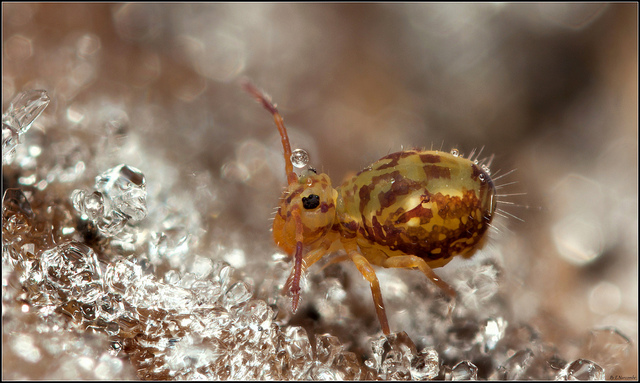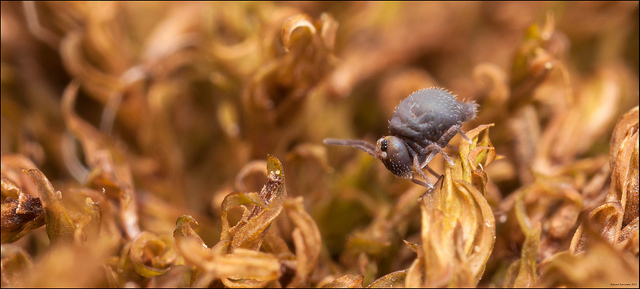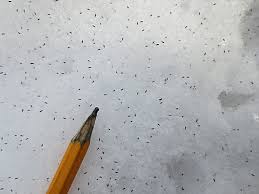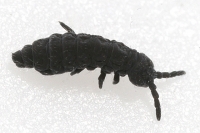 Thankfully snow fleas are benevolent little critters and, surprisingly, they are not fleas at all. Snow fleas (Hypogastrura nivicola), also known as springtails, are a type of hexapod named after the forked furcula on their abdomen which catapults them into the air. The furcula attaches to a rubber-like protein (resilin) in the exoskeleton which, with the help of muscles and blood pressure, allow the springtail to jump to a height over 100 times its body length! Springtails (Collembola) are closely related to insects, yet have fewer body segments and eyes that are not truly compound. They also are wingless and have a pair of antenna and internal mouthparts. They are so small in stature (1-2 mm) that they are often confused for flecks of dirt.
Thankfully snow fleas are benevolent little critters and, surprisingly, they are not fleas at all. Snow fleas (Hypogastrura nivicola), also known as springtails, are a type of hexapod named after the forked furcula on their abdomen which catapults them into the air. The furcula attaches to a rubber-like protein (resilin) in the exoskeleton which, with the help of muscles and blood pressure, allow the springtail to jump to a height over 100 times its body length! Springtails (Collembola) are closely related to insects, yet have fewer body segments and eyes that are not truly compound. They also are wingless and have a pair of antenna and internal mouthparts. They are so small in stature (1-2 mm) that they are often confused for flecks of dirt.
 Springtails are incredibly abundant, living on most of the Earth, including Antarctica. There are many types of springtails (pictures right and above), however, the "snow flea" springtail is typically found around the edges of thawing snow piles and snow banks. It is estimated that there are some 250,000,000 springtails per square acre. They live in a variety of habitats, including forests, gardens and fields, and are natural decomposers that eat decaying matter such as fallen leaves and old logs.
Springtails are incredibly abundant, living on most of the Earth, including Antarctica. There are many types of springtails (pictures right and above), however, the "snow flea" springtail is typically found around the edges of thawing snow piles and snow banks. It is estimated that there are some 250,000,000 springtails per square acre. They live in a variety of habitats, including forests, gardens and fields, and are natural decomposers that eat decaying matter such as fallen leaves and old logs.
Snow fleas have a couple of adaptations to help them stay active in the cold weather. Some survive by staying dehydrated since it is much harder for ice crystals to form when there is no water to freeze. Most, however, have a type of cryoprotectant (anti-freeze) in their blood that is sugar-based and very similar to the glycol used in automobiles.
Female springtails lay their eggs in the spring, which are fertilized by the transferred spermatophore of an adult male. The fertilized eggs later hatch into nymphs which eat and shed their exoskeletons continuously, resembling adults more and more with each molt. By winter they reach the adult stage, but unlike insects, will continue to molt throughout their life.
Other Fun Facts:
- Springtails are said to be harbingers of spring! They are one of the first invertebrates to emerge after (or during) winter and are easily spotted when the snow begins to melt.
- Need someone to do your dirty work? In addition to decaying matter, springtails eat fungal spores, bacteria, and scat.
- Science is inspired by nature! Scientists are developing ways to preserve human organs with the protein found in springtails' blood.
- A popsicle snow flea?! Springtails have been found living in the Arctic in temperatures as cold as -31 degrees farenheit.
- Come on, give 'em a little love. Springtails are often considered pests because they will move indoors for brief periods of time throughout the year. They are harmless though and will not bite or cause allergic reactions.

- There is no such thing as a solitary springtail. Where you find one, you will most likely find hundreds or even thousands congregating together.
- Greek origins. The name Collembola comes from the greek words colle meaning glue and embolon meaning piston or peg.
- Watch springtails in action! Click here and here to watch David Attenborough's videos about springtails.
* This article was written using the help of the book Insects: Their Natural History and Diversity by Stephen A. Marshall and the websites uwm.edu, wired.com, esa.org, and wikipedia.org.





